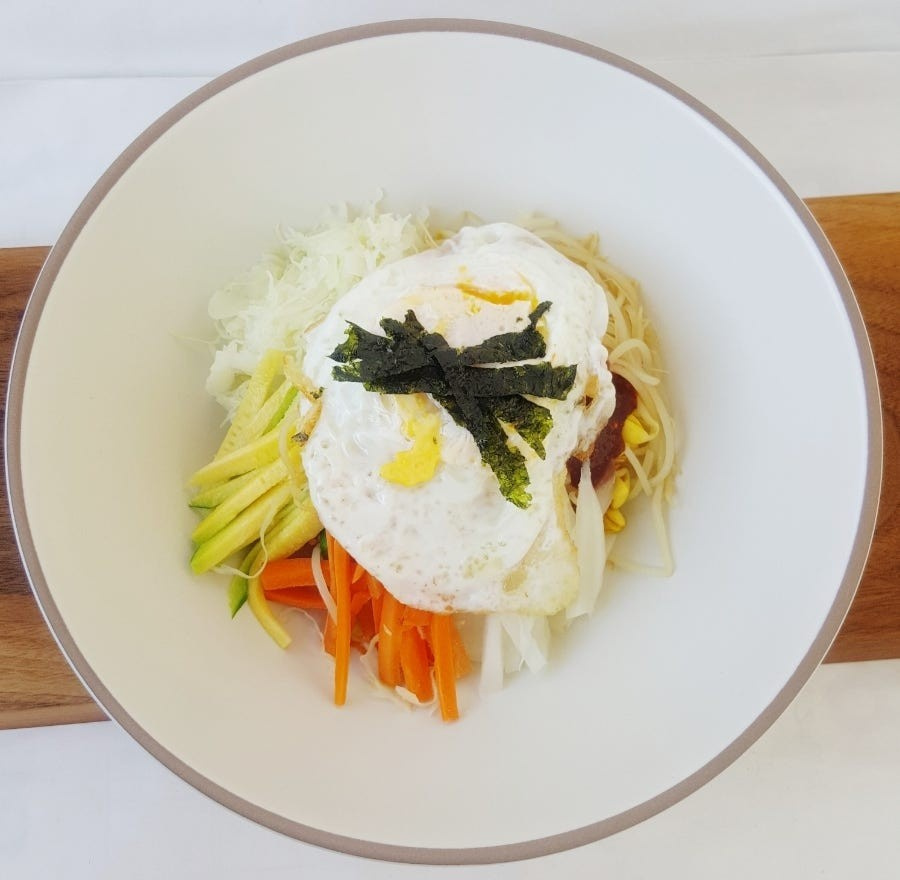Steamed Vegetable and Tofu Bibimbap
Light & Healthy Steamed Vegetable Bibimbap (Perfect for Diet Menus)

This bibimbap recipe replaces rice with tofu and steams vegetables instead of stir-frying them in oil, making it light and easy to digest. It offers the same delicious taste as regular bibimbap but with significantly fewer calories, making it an excellent choice for a healthy diet.
Vegetables (for 2 servings)- 1/4 head cabbage, thinly shredded
- 1/3 carrot, thinly julienned
- 1/3 zucchini, thinly julienned
- 1/4 daikon radish, thinly julienned
- 1 handful bean sprouts, rinsed and drained
Tofu ‘Rice’ (for 1 serving)- 150g firm tofu
- 2 Tbsp cooked rice (optional)
- 150g firm tofu
- 2 Tbsp cooked rice (optional)
Cooking Instructions
Step 1
Start by thoroughly rinsing the bean sprouts under cold running water. After washing, place them in a colander to drain any excess water.

Step 2
Thinly shred the cabbage into fine strips. Aim for pieces slightly longer than grains of rice to maintain a pleasant texture.

Step 3
Julienne the carrot, zucchini, and daikon radish into thin strips, similar in thickness to the shredded cabbage. Keeping the vegetable cuts consistent will ensure they cook evenly.

Step 4
Pour 1 cup of water into a pot and bring it to a boil over high heat. Once the water is boiling, arrange all the prepared vegetables (including the bean sprouts) evenly on a steamer rack. Cover the pot and steam over medium heat for 3 to 5 minutes.

Step 5
The steaming time may vary slightly depending on the thickness and type of vegetables used. They are perfectly cooked when tender enough to be pierced easily with a chopstick, but still retain a slight crispness. Avoid over-steaming to preserve their texture.

Step 6
Take the 150g of firm tofu and microwave it for about 2 minutes. This helps to remove excess moisture and makes it easier to mash. If you don’t have a microwave, you can wrap the tofu in a clean kitchen towel and submerge it in boiling water for 2-3 minutes to drain. Once the moisture is reduced, place the tofu in a bowl and mash it thoroughly with a fork or your hands until it has a crumbly texture. Transfer the mashed tofu to a dry pan and cook over medium-low heat, stirring with a spatula, until any remaining moisture evaporates and the tofu becomes fluffy and slightly dry. This process will improve the texture of the tofu for the bibimbap.

Step 7
Once the tofu is crumbly and dry, add the 2 tablespoons of cooked rice. Mix them together well, stirring until the rice is incorporated into the tofu. Adjust the amount of rice to your preference. Continue to stir-fry briefly.

Step 8
Transfer the cooked tofu and rice mixture to a separate bowl. Now, let’s prepare the special seasoning sauce that will elevate your bibimbap.

Step 9
In a small bowl, combine 1 tablespoon of low-sugar gochujang, 1/2 teaspoon of minced garlic, 1 teaspoon of vinegar, 1 teaspoon of allulose (or your preferred sweetener), and 1 teaspoon of sesame oil. Whisk everything together until well combined. You’ve now made a healthy, flavorful bibimbap sauce!

Step 10
Heat a non-stick pan over medium heat and add a teaspoon of cooking oil. Fry the egg to your liking – sunny-side up, over easy, or over hard. A runny yolk adds a wonderful richness to the bibimbap.

Step 11
Now, it’s time to assemble your beautiful bibimbap. Place the prepared tofu and rice mixture in the center of your serving bowl, shaping it nicely.

Step 12
Arrange the colorful steamed vegetables attractively around the tofu ‘rice’. Once the vegetables are artfully placed, add about 1 tablespoon of the prepared low-sugar gochujang sauce to the center or to the side.

Step 13
Carefully place the freshly fried egg on top of the vegetables. For an extra touch of flavor and texture, sprinkle some crumbled roasted seaweed (gim/nori) over the top, if desired. Your healthy and delicious Steamed Vegetable and Tofu Bibimbap is now ready!

Step 14
Enjoy your bibimbap by mixing everything together with the low-sugar gochujang sauce. It’s a nutritious and satisfying meal!



